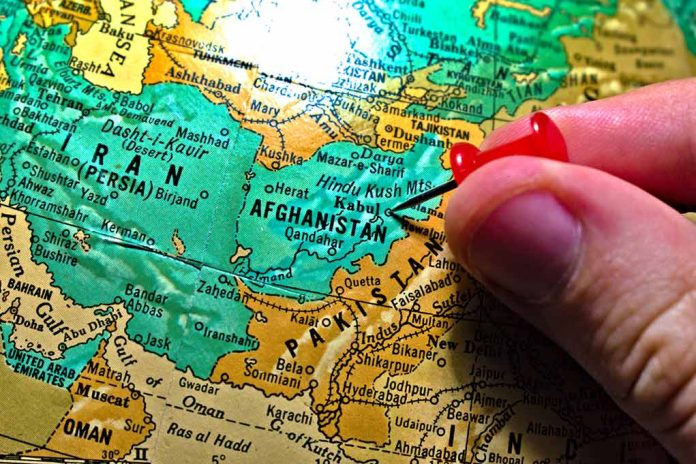
Taliban’s $3.4 billion revenue surge is fueling a dangerous redistribution of abandoned U.S. military equipment to terrorist organizations worldwide, transforming Afghanistan back into a thriving jihadist haven.
Key Takeaways
- The Taliban generated $3.4 billion in revenue over the past year, increasing their cash supply by 14%, strengthening their grip on Afghanistan.
- Approximately $7.12 billion worth of abandoned U.S. military equipment remains in Taliban possession, much of which is being transferred to terrorist affiliates or sold on the black market.
- More than two dozen terrorist organizations, including ISIS-K and TTP, are currently active in Afghanistan, using it as a haven for operations.
- Despite the 2020 Doha agreement commitments, U.S. intelligence confirms the Taliban maintains close ties with al-Qaeda and other extremist groups.
- The Biden administration initially provided nearly $4 billion in aid to Taliban-controlled Afghanistan before terminating most programs due to Taliban interference and mismanagement.
Afghanistan’s Resurgence as a Terrorist Sanctuary
Afghanistan has rapidly transformed back into the world’s premier haven for terrorist organizations following the U.S. withdrawal in 2021. With Taliban revenue reaching $3.4 billion this year, the regime is better positioned than ever to support extremist activities. This 14% increase in their financial resources has coincided with the proliferation of at least two dozen terrorist groups now operating freely within Afghanistan’s borders, including dangerous entities such as ISIS-K and the Tehrik-i-Taliban Pakistan (TTP).
“Terrorist groups continued to use Afghan soil to train and plan attacks, and a ‘small but steady’ flow of foreign terrorists continued to travel to Afghanistan and join one of over two dozen terror groups based there,” said Special Inspector General for Afghanistan Reconstruction (SIGAR)
The situation is particularly alarming given the Taliban’s continued ideological commitment to jihad against the West. Their leadership, particularly supreme leader Maulvi Hibatullah Akhundzada, shows no intention of limiting space for terrorist organizations like al-Qaeda, instead emphasizing that their struggle continues despite having reclaimed territorial control. This position directly contradicts promises made during peace negotiations with the United States.
The Catastrophic U.S. Equipment Windfall
One of the most concerning aspects of the current situation is the massive arsenal of American weapons and equipment now in Taliban hands. During the chaotic 2021 withdrawal, the U.S. military abandoned approximately 78 aircraft, 40,000 military vehicles, and over 300,000 weapons. This equipment, valued at approximately $7.12 billion, represents one of the largest unintentional transfers of military hardware to a hostile entity in modern history.
“Weapons seized from the former Afghan National Army,” according to Special Inspector General for Afghanistan Reconstruction (SIGAR)
Intelligence reports indicate the Taliban has been actively redistributing these weapons, either by directly transferring them to allied terrorist organizations or selling them on the black market to generate additional revenue. This proliferation of advanced weaponry significantly increases the capabilities of extremist groups throughout the region and potentially worldwide, creating a far more dangerous security environment than existed before the U.S. withdrawal.
The Taliban’s Continuing Ideological War
Despite attempts by some Taliban officials to present a more moderate face to the international community, the group’s leadership remains firmly committed to its fundamentalist ideology and global jihadist ambitions. This split approach creates a dangerous situation where some Taliban representatives seek international recognition and aid while the core leadership continues supporting extremist causes and organizations.
“The infidels were not fighting us for land, for money, and no other thing, except our ideology and faith… and they decided to suppress our ideology… and stop the jihad, ban the sharia… the fight still hasn’t ended, it still exists. And it won’t end until the day of judgement,” said by Maulvi Hibatullah Akhundzada
The Taliban’s continued harboring of al-Qaeda was starkly demonstrated by the discovery and elimination of al-Qaeda leader Ayman al-Zawahri in a comfortable residence in Kabul in 2022. This incident confirmed what many security experts had warned about: despite public assurances to the contrary, the Taliban’s relationship with al-Qaeda remains intact, with high-level terrorist leaders receiving protection and support within Afghanistan.
Failed U.S. Aid and Oversight
Adding insult to injury, the Biden administration initially provided nearly $4 billion in humanitarian aid to Afghanistan after the Taliban takeover, despite clear evidence that these funds were subject to fraud, mismanagement, and direct Taliban control. American aid partners were forced to pay the Taliban at least $10.9 million in “fees” to operate in the country, effectively funding the very regime that was redistributing U.S. weapons to terrorist organizations.
“We have won the war and America has lost,” said Haji Hekmat
Thankfully, most of these aid programs have now been terminated, with the State Department freezing emergency food assistance due to Taliban interference and USAID operations being dissolved. This action has saved American taxpayers over $1 billion, but the damage was already done. The Special Inspector General for Afghanistan Reconstruction (SIGAR), which provided crucial oversight of U.S.-Afghanistan relations, is set to cease operations early next year, further limiting visibility into the unfolding crisis.
A Growing Threat to Global Security
The combination of increased financial resources, advanced military equipment, and ideological commitment makes today’s Taliban-controlled Afghanistan potentially more dangerous than the pre-9/11 version. President Trump’s warnings about the consequences of a hasty and poorly executed withdrawal have proven prescient, as the terrorist sanctuary that was dismantled after 2001 has not only been restored but strengthened with American tax dollars and equipment.
“We are ready for anything. We are prepared for peace, and we are fully prepared for jihad,” said Haji Hekmat
With U.S. counterterrorism capabilities in the region severely limited by the lack of on-ground intelligence assets, the threat will only grow more severe with time. The billions in revenue now flowing to the Taliban and their ongoing redistribution of American weapons create an environment ripe for the planning and execution of attacks against U.S. interests and allies. This preventable situation represents one of the most significant foreign policy failures in recent American history.







